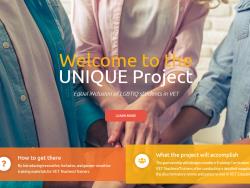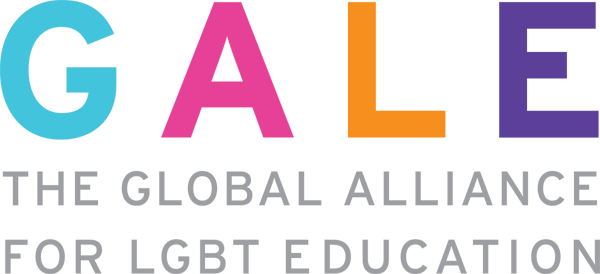European partnership develops e-course for vocational teachers

24 July 2023 - The European UNIQUE-project partnership launched its elaborate e-course on how to give attention to sexual and gender diversity for vocational teachers. The free online resource is the main tool in a transnational strategy to recruit and train teacher-ambassadors, who should undertake initiatives to make their vocational course more LGBTIQ+ inclusive.
The course
The MOOC (Massive Open Online Course) consists of 44 lesson units, divided over 4 modules:
- An introduction of basic concepts
- How to embed diversity and inclusion in lessons
- How to suggest strategies to make the school environment more inclusive
- How to support individual LGBTIQ+ learners
In total, the course requires an investment of about 30 hours. In the UNIQUE project, the vocational teachers were also invited to take part in additional live workshops.
The challenge of the information perspective
Peter Dankmeijer (GALE) developed a few units and advised on other units. He notes the development had to deal with a number of challenges.
“The most challenging part for me was the different views in the partnership on how to teach. In many countries, the perspective is that teaching entails giving correct and complete information about topics and offering concrete guidelines how to do things. This is not the view GALE takes on training about sexual and gender diversity. The greatest challenge of training about LGBTIQ+ issues is not that students or teachers don’t have enough information. The main challenge is they have negative emotions and attitudes and don’t want to receive information that does not confirm their bias. Or they may have a rather positive attitude but feel fear about what might happen when they raise this topic.
In such contexts, giving (a lot of) information may increase their resistance and insecurity. This can happen especially when the information is formulated in politically correct language and specific demands they may feel are unfeasible in their situation. Instead the content of a course should be tailored and connected to the situation of a specific sector of students and teachers. In my opinion, a good training on sexual and gender diversity should focus on the emotional and attitudinal aspects first. When the right attitude is there, teachers can search the concrete suggestions online or invent them themselves based on their existing expertise, so the information in a course becomes the icing on the cake rather than the cake itself.
Some of the partners in this project agreed with this perspective, but did not know how to address emotions and attitudes of teachers. And this is a true challenge. Especially vocational teachers often think speaking about emotions in class is “unprofessional” because students only need to learn “hard” skills. Incorporating how to increase emotional intelligence in an online course is another challenge. However, I felt fine advising my partners on this.
For me, the real hard thing was how to engage project partners who seemed only interested in an approach that was politically correct and highly informational. One example of this was a unit with an elaborate explanation why using correct pronouns is important and the concrete advise to introduce using such pronouns the first lesson of the year. Note that this course is meant for teachers in Greece, Cyprus, Croatia, Poland and Bulgaria. Most of the partner organizations were already afraid of mentioning explicitly that this project was about LGBTIQ+ issues. Some teachers walked out of meetings angrily when they discovered that is was about LGBTIQ+. In one country, an employee of the Ministry of Education (re)published a Facebook meme which said that LGBT people were attempting to destroy children. So the level of tolerance was extremely low and we should take considerable challenges of implementation into account. I value the good practice of using proper pronouns, but the way of promoting such a practice in this way in these contexts without any concern for the consequences in class, in the school or in this project felt quite insensitive to me. And I struggled with how to advise my partners on this, especially the partners who were not open for a dialogue on such challenges. I only partly succeeded in dealing with this challenge. The published course is a mix of units which copy politically correct information from American websites and other units which focus on emotional intelligence, reflection and empowerment.”
A levelled approach
“One advise I offered the project partnership was to divide the course in levels. My proposal was to use the levels of aspirant, novice, senior and specialist. This division is consistent with several educational theories on how gradually build up expertise, and it also connects to the European Qualifications Framework (EQF).
The level of aspirants would focus on learners who have objections to the topic or who are not yet sure if they dare to engage with sexual and gender diversity. The goals for this level would be to explore and overcome ‘limiting objections’ (my less offensive training term for prejudice) and to get motivated, but not yet on actually doing something concrete.
The level of novices would focus on teachers who have decided to do something and who’s need is to get concrete but not too complicated suggestions on what to do now. Novices may still be insecure about consequences, so the suggestions should be rather simple and stay within their comfort zone. On the level of seniors, the course participants would be able to go more in-depth. They can be encouraged to be more creative. They can go beyond following simple suggestions and to make variations on simple interventions. They can try out more challenging classroom techniques like roleplay and simulation. Specialists would be able to reflect on all this, to coach colleagues and to invent and present new interventions.
Although my suggestion to use levels was more or less taken over, it became muddled in the course. Rather than offering separate modules for aspirants, novices and seniors, each module was divided into topics and the each topic was divided in 3 units or aspirants, novices and seniors. The level of specialist was deemed to be overdone for this project, despite our hope that teacher-ambassadors would try to influence their institute’s policy and even national policy. The aspirant, novice and senior levels were not labeled as such, so this distinction became invisible for the learners. The participants are not encouraged to first take aspirant levels, but get a mix of topics and the implicit expectation is to follow the course from start to finish.
The division of modules in topics rather than levels once more reflects the implicit focus on information rather than on gradual development of attitudes and skills. I fear this will have consequence for the willingness of teachers to engage in this rather lengthy course. Especially teachers with doubts about whether they should be associated with the ‘controversial’ or even ‘objectionable’ topic of sexual and gender diversity are not likely to feel motivated to engage in the course. Their question will be: why do we need to do 30-60 hours of training on this small issue? I never had an LGBTIQ+ student in class. This question could have been be addressed in an aspirant course, but now the fresh participants are directly confronted in their first lesson with the full and politically correct definitions of all concepts relating to sexual and gender diversity.”
Learning experiences
“As always, the most challenging projects are also the projects that offer the most useful learning experiences. The rigid attitude I faced of partners who believed that giving elaborate and correct (sanctioned by international organizations) information would change teacher’s minds requires much more attention and sensitivity in the future. In this and other projects I noticed that offering a good kick-off training that focuses on how emotional rejection of sexual and gender diversity works, creates an opening for dialogue and a common understanding in projects. We have to make sure that all the key players who co-develop a product are present in such a training, otherwise the team is not aligned and different views on sexual and gender diversity and on training and teaching in general may become divisive elements in the project strategy.
Another learning experience is the importance of having clear view of how to train traditional teachers in why and how to increase the emotional intelligence of their students. They should incorporate this in their own personal way of teaching but also integrate this systematically in their (team) curriculum. If projects want to successfully promote ‘horizontal’ skills (relevant for all subjects) like tolerance and sensitivity for diversity, they need an explicit strategy on how to overcome the old-fashioned focus on transferring knowledge, and how to gradually but systematically engage learners (students and teachers, and their managers) on increasing level of awareness, motivation, empowerment and supportive action.”
Sources: the UNIQUE-website; the free e-course; the summary of the UNIQUE-project on the GALE website


